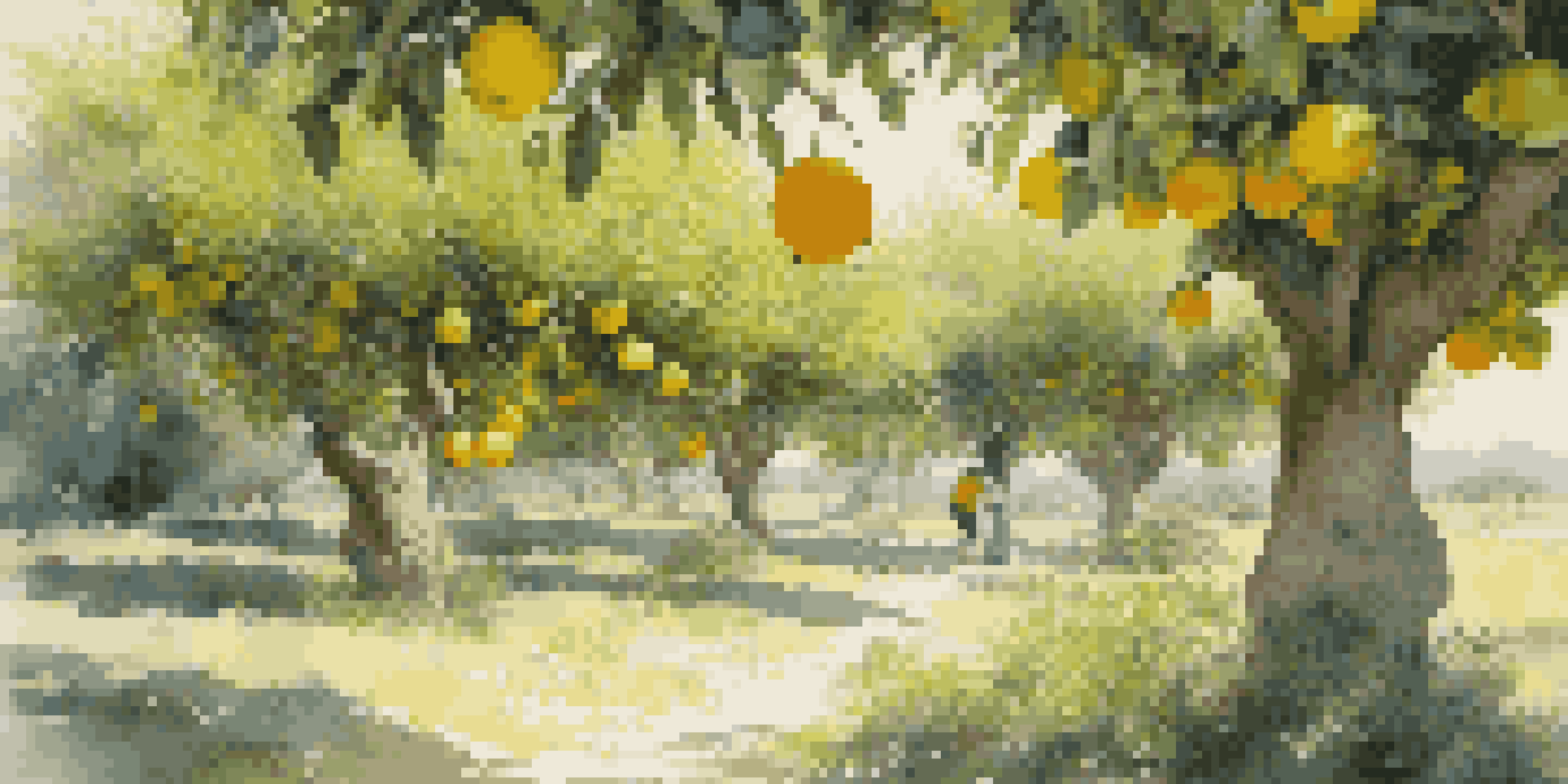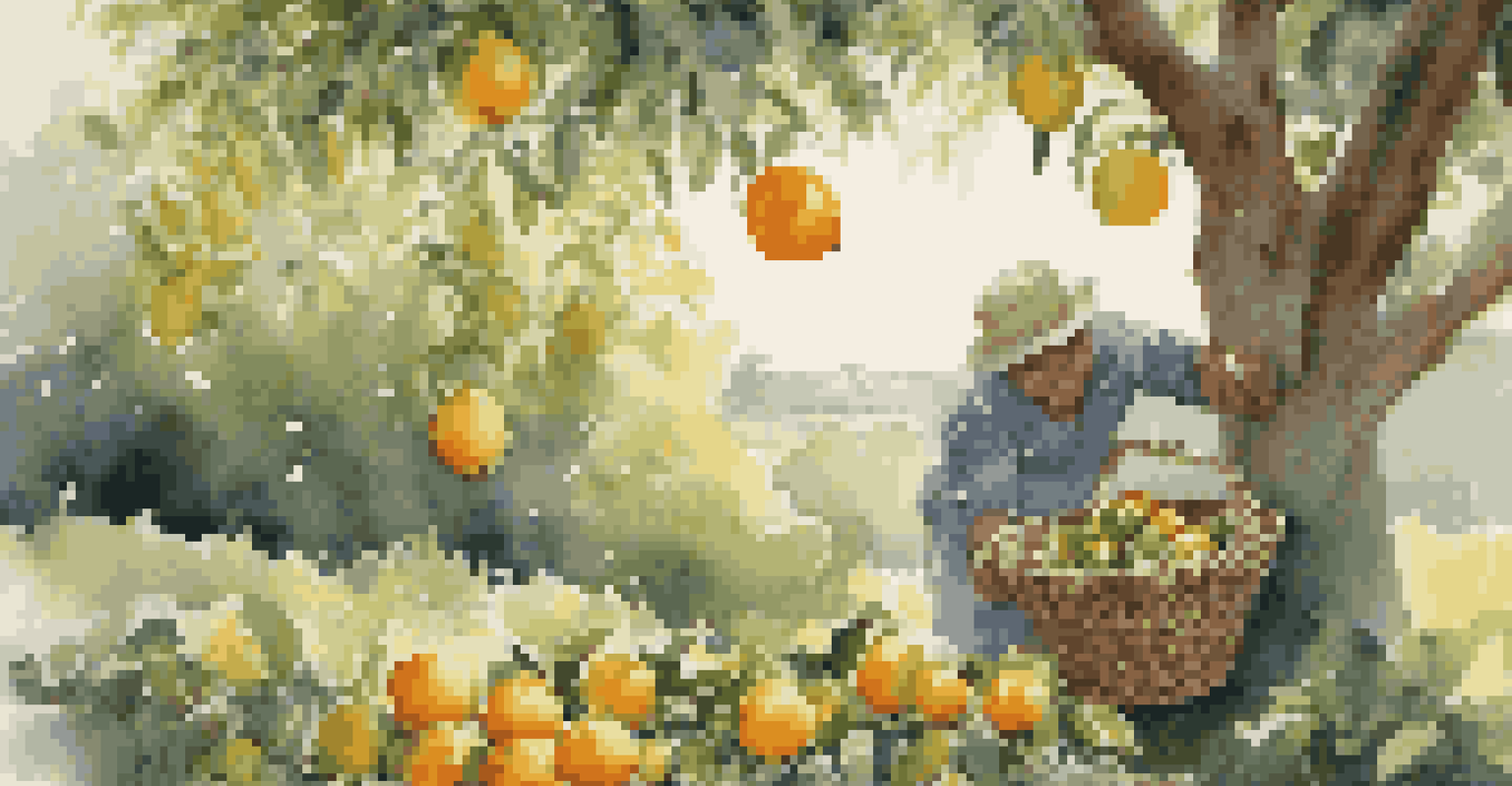Foraging for Wild Citrus: Discovering Nature's Zesty Fruits

What is Wild Citrus and Why Forage for It?
Wild citrus refers to various citrus fruits that grow naturally outside of cultivated orchards. These fruits, which can include species like wild lemons, limes, and mandarins, offer unique flavors and aromas that can enhance your culinary endeavors. Foraging for wild citrus not only connects you with nature but also allows you to discover flavors that supermarket fruits can't replicate.
In every walk with nature one receives far more than he seeks.
Imagine walking through a sun-drenched grove, the air filled with the sweet and tangy scent of ripe citrus. It’s a sensory experience that heightens your appreciation for the environment. This practice also encourages sustainable eating, as foragers often leave the ecosystem intact while harvesting responsibly.
Whether you're a seasoned forager or a curious beginner, the thrill of finding wild citrus can be incredibly rewarding. It's not just about the fruit; it's also about the adventure and the stories that come with it.
Identifying Wild Citrus Varieties in Your Area
Before you head out, it's essential to know which wild citrus varieties might be growing in your region. Common types include the native wild lime and various species of wild oranges, each with distinctive characteristics. Researching local flora can help you identify these fruits and determine the best times for foraging.

Take a moment to familiarize yourself with the leaves, flowers, and fruits of these plants. Many wild citrus trees have thorny branches and shiny leaves, making them stand out in their environment. A handy foraging guide or app can enhance your ability to identify these fruits accurately and safely.
Discover Wild Citrus Varieties
Identifying local wild citrus varieties enhances your foraging experience and connects you with unique flavors.
Remember, not all citrus-like fruits are edible. Always verify your findings with a reliable source to avoid any mishaps. The joy of discovery is amplified when you can confidently recognize the treasures that nature offers.
The Best Seasons for Foraging Wild Citrus
Timing is everything when it comes to foraging wild citrus. Most varieties are typically ripe in late winter to early spring, but this can vary depending on your location. Understanding local climate patterns can help you pinpoint the optimal foraging season.
The earth has music for those who listen.
During this time, you might find citrus fruits bursting with flavor and ready for harvest. The vibrant colors of ripe fruits against the green foliage create a striking visual that’s hard to resist. Planning your foraging trips around these seasonal peaks can lead to a more fruitful experience.
Don't forget to enjoy the process! Taking a leisurely stroll while you search for ripe fruits allows you to appreciate the beauty of nature. Taking in the sights and sounds around you can enhance your foraging experience and make it even more memorable.
Tools and Techniques for Successful Foraging
When foraging for wild citrus, having the right tools can make all the difference. A sturdy pair of pruning shears, a basket for collecting fruits, and gloves to protect your hands from thorns are essential items to carry. Don’t forget to bring plenty of water and snacks to keep your energy up during your adventure.
Techniques such as looking for trees along trails or near water sources can increase your chances of finding wild citrus. You might also want to scout out areas where local wildlife congregates, as they often lead to fruitful discoveries. Patience and observation are key when searching for these zesty gems.
Forage Responsibly and Mindfully
Responsible harvesting practices ensure wild citrus populations remain healthy for future foragers and preserve the ecosystem.
Documenting your finds with photos or notes can help you remember the best spots for future foraging trips. Plus, sharing your discoveries with friends and family can inspire them to join you on your next adventure!
Harvesting Wild Citrus Responsibly
Responsible harvesting is crucial to ensure that wild citrus populations remain healthy for future foragers. Only take what you need, leaving plenty of fruit for wildlife and fellow foragers to enjoy. This not only preserves the ecosystem but also fosters a sense of community among those who appreciate nature's bounty.
A good rule of thumb is to harvest no more than 10% of the fruit from a single tree. This practice allows trees to continue producing fruit and helps maintain the balance of the local ecosystem. Respecting nature while foraging ensures that everyone can benefit from these wild treasures.
Always remember to leave the environment as you found it. Clean up any debris you may have created during your foraging adventure to protect the habitats of plants and animals. A little mindfulness goes a long way in preserving these beautiful natural spaces.
Delicious Ways to Use Wild Citrus in Your Cooking
Once you've successfully foraged wild citrus, the next exciting step is incorporating it into your kitchen creations! These fruits can be used in a variety of ways, from zesty marinades to refreshing drinks. Their bold flavors can elevate simple dishes, making them an exciting addition to your culinary repertoire.
Consider making a wild citrus salad with mixed greens, nuts, and a tangy vinaigrette. Or, use the zest and juice to enhance baked goods like cakes and muffins. The unique flavors of wild citrus can add a delightful twist to your favorite recipes, impressing friends and family alike.
Creative Uses for Wild Citrus
Incorporating wild citrus into your cooking can elevate dishes and allow you to savor the unique flavors year-round.
Don’t forget about preserving your bounty! Making marmalades, syrups, or infusing oils with wild citrus can extend the enjoyment of your foraged finds. These homemade creations can serve as thoughtful gifts or simply a way to savor nature's flavors year-round.
Safety Tips for Foraging Wild Citrus and Beyond
While foraging is a fun and rewarding experience, safety should always be a priority. Be aware of your surroundings and avoid areas that may have been treated with pesticides or other harmful chemicals. Familiarize yourself with any poisonous plants that may grow alongside wild citrus to ensure a safe foraging experience.
It's also wise to forage with a friend or group, especially if you're new to the practice. Having someone with you can provide an extra layer of safety and make the adventure more enjoyable. Plus, sharing the excitement of discovery is always more fun with company!

Lastly, trust your instincts. If something looks or smells off, it’s better to err on the side of caution. Foraging should be a joyful experience, so listen to your gut and enjoy the beauty of nature without worry.